engine NISSAN PATROL 1998 Y61 / 5.G Engine Lubrication And Cooling System User Guide
[x] Cancel search | Manufacturer: NISSAN, Model Year: 1998, Model line: PATROL, Model: NISSAN PATROL 1998 Y61 / 5.GPages: 22, PDF Size: 0.67 MB
Page 12 of 22
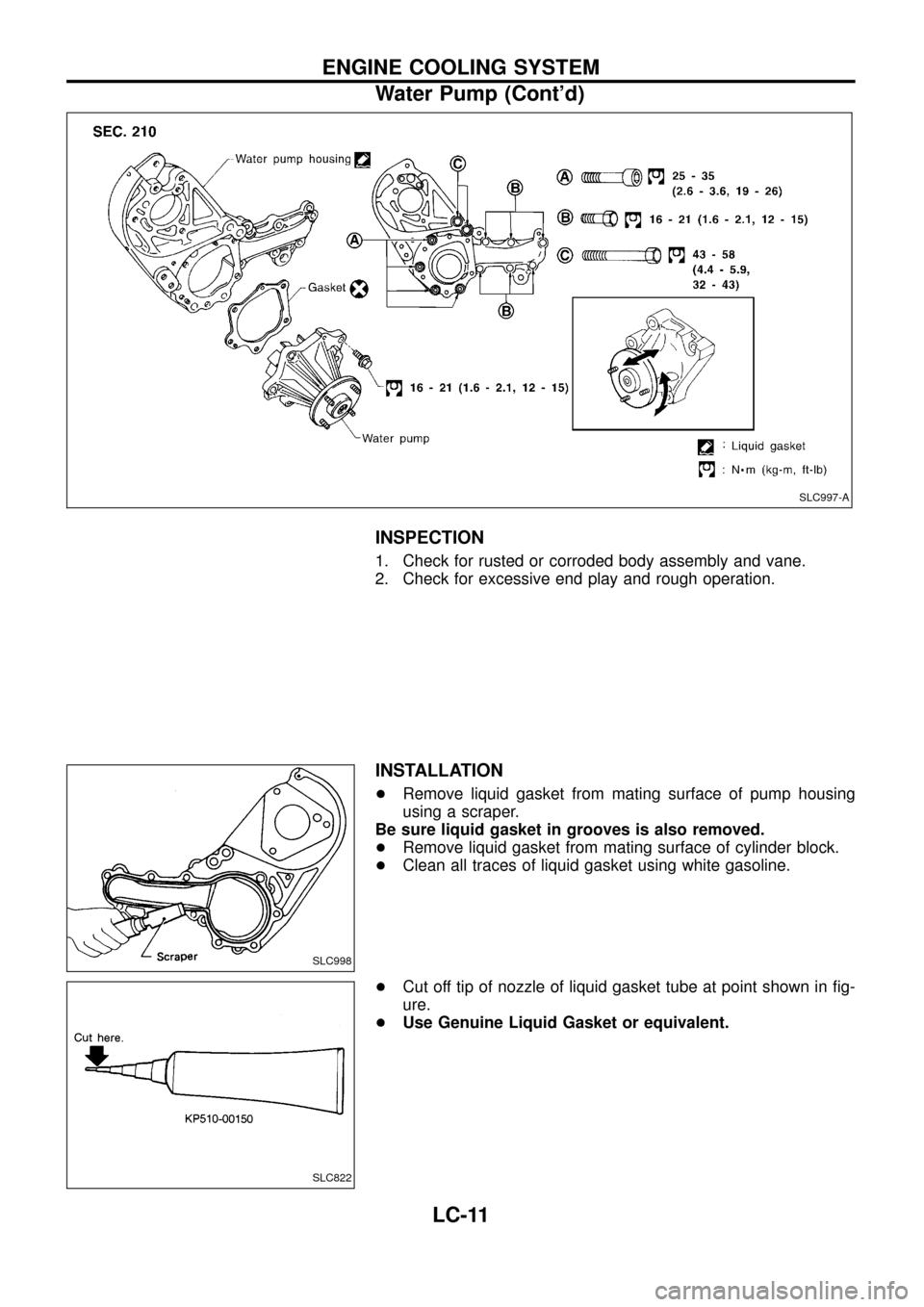
INSPECTION
1. Check for rusted or corroded body assembly and vane.
2. Check for excessive end play and rough operation.
INSTALLATION
+Remove liquid gasket from mating surface of pump housing
using a scraper.
Be sure liquid gasket in grooves is also removed.
+Remove liquid gasket from mating surface of cylinder block.
+Clean all traces of liquid gasket using white gasoline.
+Cut off tip of nozzle of liquid gasket tube at point shown in ®g-
ure.
+Use Genuine Liquid Gasket or equivalent.
SLC997-A
SLC998
SLC822
ENGINE COOLING SYSTEM
Water Pump (Cont'd)
LC-11
Page 13 of 22

+Apply a continuous bead of liquid gasket to mating surface of
pump housing as shown.
a. Be sure diameter of liquid gasket is within 2.0 to 3.0 mm
(0.079 to 0.118 in) dia. range.
b. Attach pump housing to cylinder block within ®ve minutes
of applying liquid gasket.
c. After installing pump housing, wait at least 30 minutes
before starting engine.
Thermostat
INSPECTION
1. Check valve seating condition at ordinary temperatures. It
should seat tightly.
2. Check valve opening temperature and maximum valve lift.
Valve opening temperature CÉ (ÉF) 82.0 (180)
Maximum valve lift mm/ÉC (in/ÉF) 10/90 (0.39/194)
3. Then check if valve closes at 5ÉC (9ÉF) below valve opening
temperature.
INSTALLATION
+Remove liquid gasket from mating surface of thermostat using
a scraper.
+Similarly, remove liquid gasket from mating surface of cylinder
block.
+Clean all traces of liquid gasket using white gasoline.
SLC001A
SLC002A
SLC343
SLC790
Scraper
ENGINE COOLING SYSTEM
Water Pump (Cont'd)
LC-12
Page 14 of 22
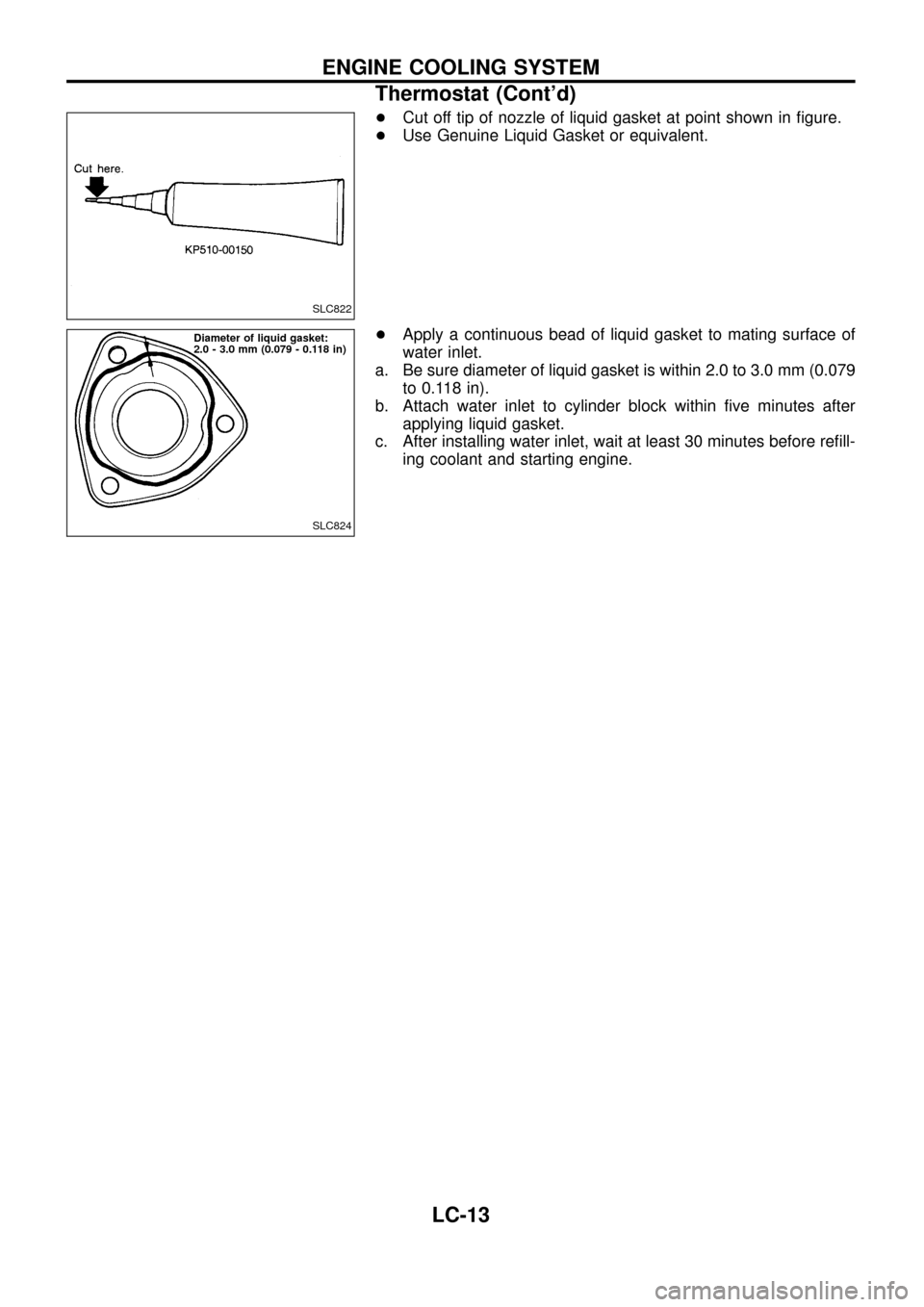
+Cut off tip of nozzle of liquid gasket at point shown in ®gure.
+Use Genuine Liquid Gasket or equivalent.
+Apply a continuous bead of liquid gasket to mating surface of
water inlet.
a. Be sure diameter of liquid gasket is within 2.0 to 3.0 mm (0.079
to 0.118 in).
b. Attach water inlet to cylinder block within ®ve minutes after
applying liquid gasket.
c. After installing water inlet, wait at least 30 minutes before re®ll-
ing coolant and starting engine.
SLC822
SLC824 Diameter of liquid gasket:
2.0 - 3.0 mm (0.079 - 0.118 in)
ENGINE COOLING SYSTEM
Thermostat (Cont'd)
LC-13
Page 15 of 22

Radiator
REMOVAL AND INSTALLATION
1. Remove under cover.
2. Drain coolant from radiator drain plug.
3. Disconnect radiator upper and lower hoses.
4. Remove radiator lower shroud.
5. Disconnect reservoir tank hose.
6. Remove radiator.
7. After repairing or replacing radiator, install any part removed in
reverse order of removal.
Re®lling Engine Coolant
For details on re®lling engine coolant, refer to MA section (``REFILL-
ING ENGINE COOLANT'', ``Changing Engine Coolant'').
SLC198B
ENGINE COOLING SYSTEM
LC-14
Page 16 of 22

Cooling Fan (Crankshaft driven)
DISASSEMBLY AND INSTALLATION
+Do not release the drive belt tension by removing the fan/water
pump pulley.
+Fan coupling cannot be disassembled and should be replaced
as a unit. If front markj
Fis present, install fan so that side
markedj
Ffaces the front.
+Install the drive belt only after the fan and fan coupling to water
pump ¯ange bolts/nuts have been properly torqued.
+Proper alignment of these components is essential. Improper
alignment will cause them to wobble and may eventually cause
the fan to separate from the water pump causing extensive
damage.
INSPECTION
Check fan coupling for damage, oil leakage and bent bimetal.
Cooling Fan (Motor driven)
Cooling fan is controlled by ECM. For details, refer to ``Cooling
Fan'', ``TROUBLE DIAGNOSIS FOR DTC 28'' in EC section.
SLC176B
SLC072
SLC177B
ENGINE COOLING SYSTEM
LC-15
Page 17 of 22

Radiator (Aluminum type)
Aluminum radiator can be disassembled by using special proce-
dures and special service tools.
DISASSEMBLY
1. Remove tank with Tool.
+Grip the crimped edge and bend it upwards so that Tool slips
off.
Do not bend excessively.
SLC882AB
SLC903
SLC893
ENGINE COOLING SYSTEM
LC-16
Page 18 of 22
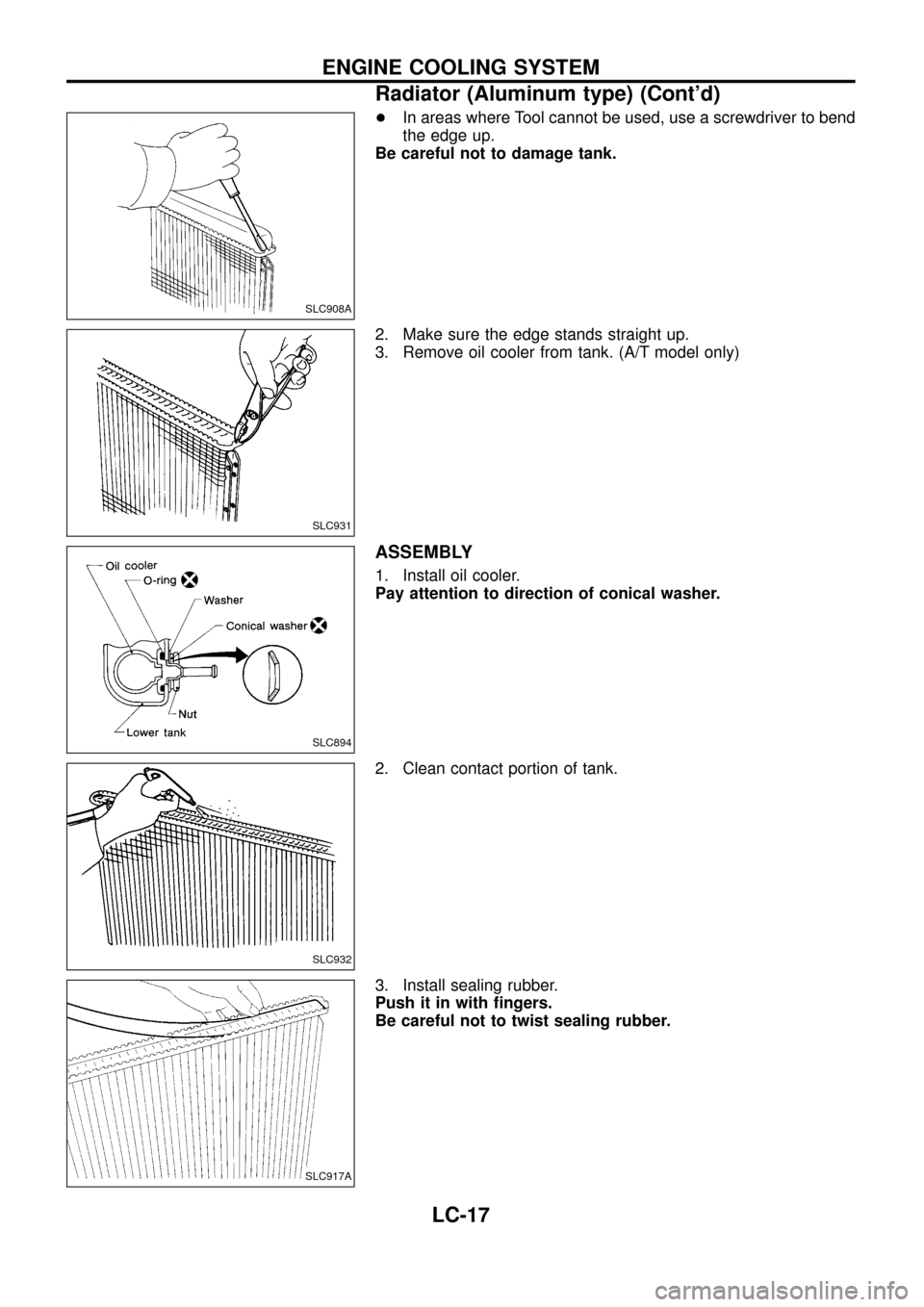
+In areas where Tool cannot be used, use a screwdriver to bend
the edge up.
Be careful not to damage tank.
2. Make sure the edge stands straight up.
3. Remove oil cooler from tank. (A/T model only)
ASSEMBLY
1. Install oil cooler.
Pay attention to direction of conical washer.
2. Clean contact portion of tank.
3. Install sealing rubber.
Push it in with ®ngers.
Be careful not to twist sealing rubber.
SLC908A
SLC931
SLC894
SLC932
SLC917A
ENGINE COOLING SYSTEM
Radiator (Aluminum type) (Cont'd)
LC-17
Page 19 of 22
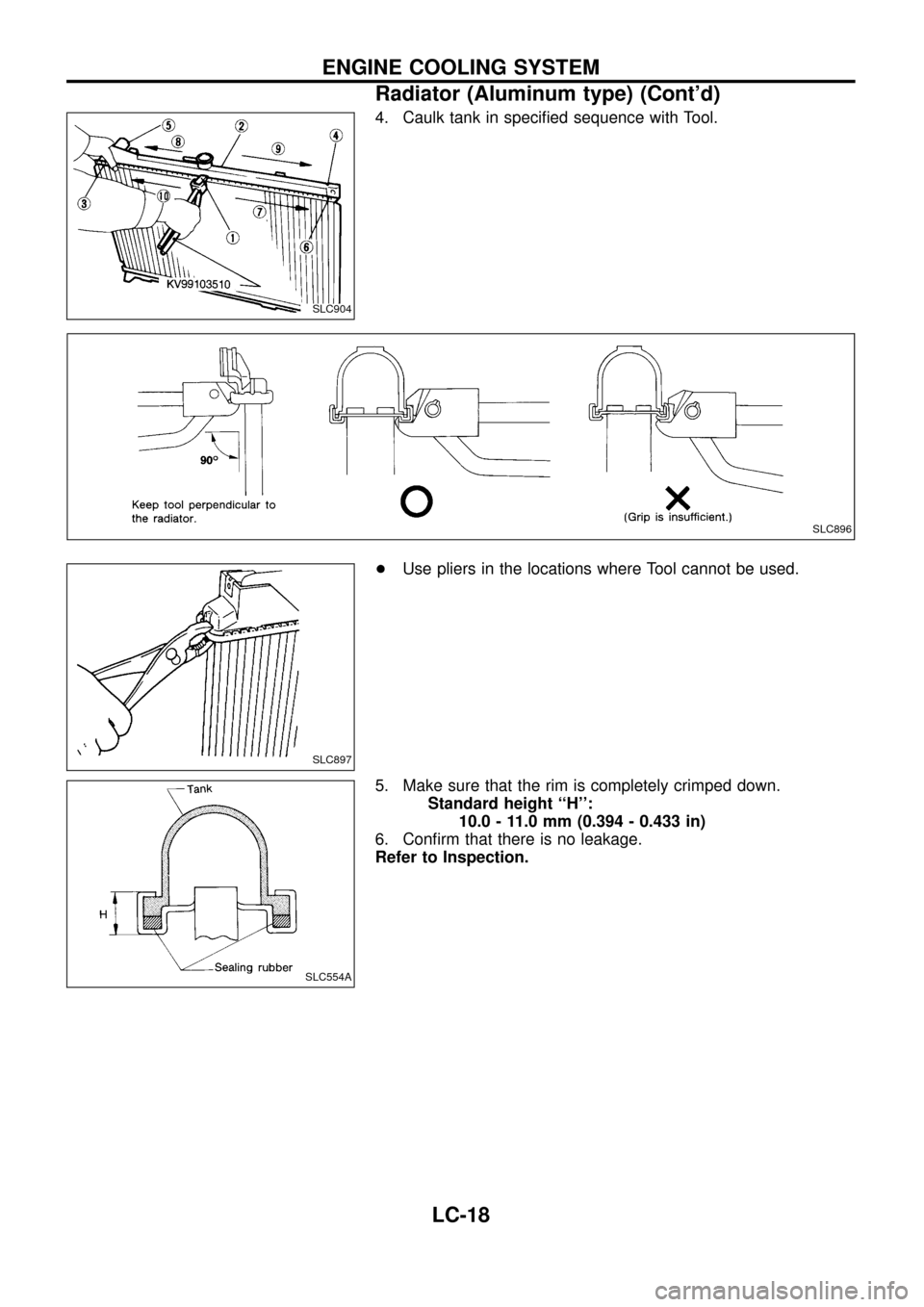
4. Caulk tank in speci®ed sequence with Tool.
+Use pliers in the locations where Tool cannot be used.
5. Make sure that the rim is completely crimped down.
Standard height ``H'':
10.0 - 11.0 mm (0.394 - 0.433 in)
6. Con®rm that there is no leakage.
Refer to Inspection.
SLC904
SLC896
SLC897
SLC554A
ENGINE COOLING SYSTEM
Radiator (Aluminum type) (Cont'd)
LC-18
Page 20 of 22

INSPECTION
1. Apply pressure with Tool.
Speci®ed pressure value:
98 kPa (0.98 bar, 1.0 kg/cm
2, 14 psi)
WARNING:
To prevent the risk of the hose coming undone while under
pressure, securely fasten it down with a hose clamp.
Attach a hose to the oil cooler as well.
2. Check for leakage.
SLC933
SLC934
ENGINE COOLING SYSTEM
Radiator (Aluminum type) (Cont'd)
LC-19
Page 21 of 22
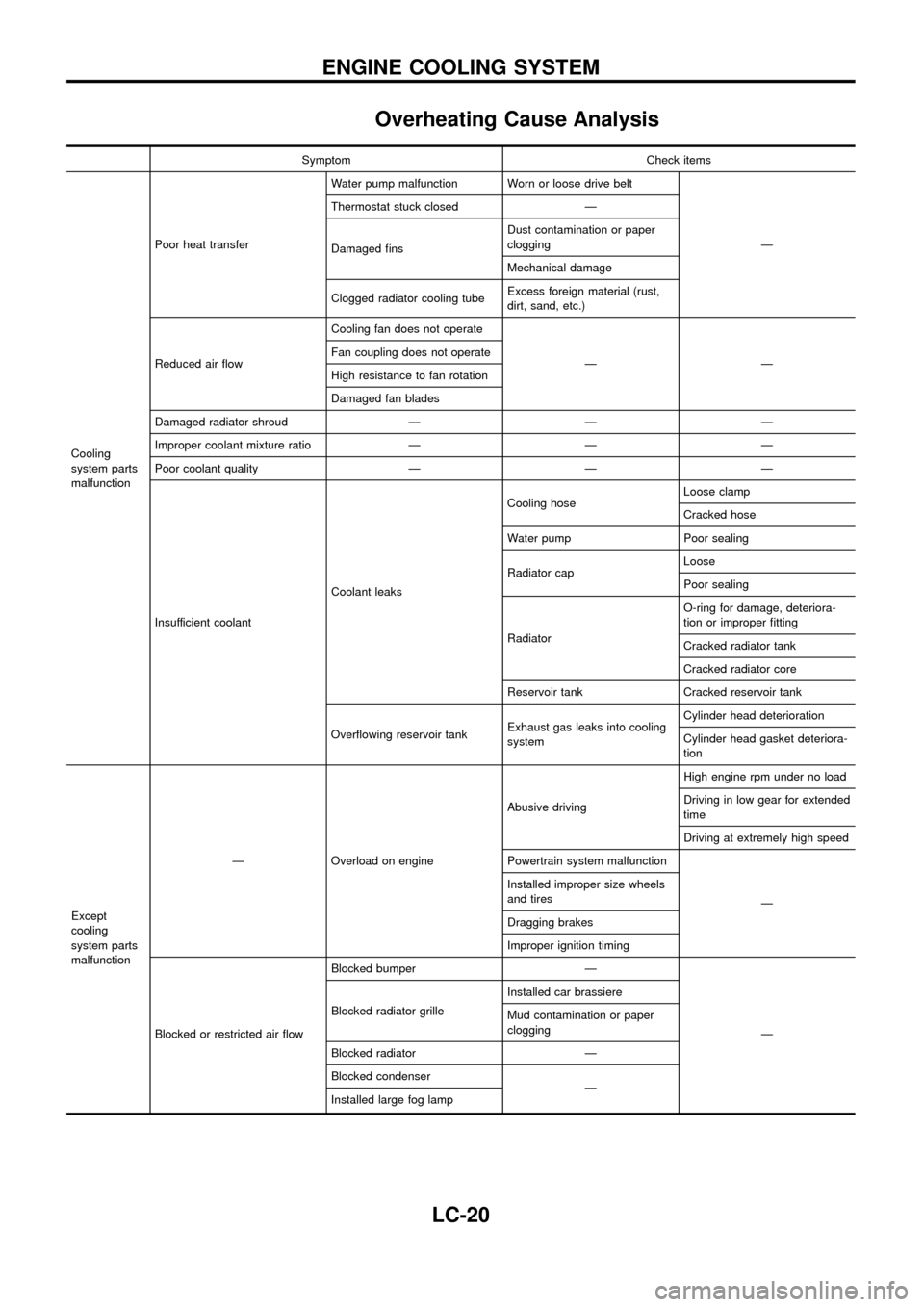
Overheating Cause Analysis
Symptom Check items
Cooling
system parts
malfunctionPoor heat transferWater pump malfunction Worn or loose drive belt
Ð Thermostat stuck closed Ð
Damaged ®nsDust contamination or paper
clogging
Mechanical damage
Clogged radiator cooling tubeExcess foreign material (rust,
dirt, sand, etc.)
Reduced air ¯owCooling fan does not operate
ÐÐ Fan coupling does not operate
High resistance to fan rotation
Damaged fan blades
Damaged radiator shroud Ð Ð Ð
Improper coolant mixture ratio Ð Ð Ð
Poor coolant quality Ð Ð Ð
Insufficient coolantCoolant leaksCooling hoseLoose clamp
Cracked hose
Water pump Poor sealing
Radiator capLoose
Poor sealing
RadiatorO-ring for damage, deteriora-
tion or improper ®tting
Cracked radiator tank
Cracked radiator core
Reservoir tank Cracked reservoir tank
Over¯owing reservoir tankExhaust gas leaks into cooling
systemCylinder head deterioration
Cylinder head gasket deteriora-
tion
Except
cooling
system parts
malfunctionÐ Overload on engineAbusive drivingHigh engine rpm under no load
Driving in low gear for extended
time
Driving at extremely high speed
Powertrain system malfunction
Ð Installed improper size wheels
and tires
Dragging brakes
Improper ignition timing
Blocked or restricted air ¯owBlocked bumper Ð
Ð Blocked radiator grilleInstalled car brassiere
Mud contamination or paper
clogging
Blocked radiator Ð
Blocked condenser
Ð
Installed large fog lamp
ENGINE COOLING SYSTEM
LC-20